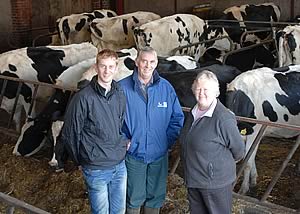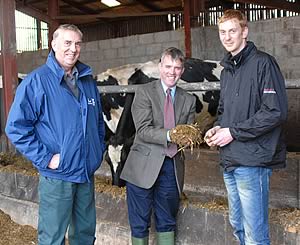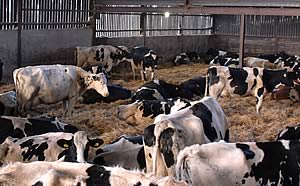 |
|||||||||
|
|||||||||||||||||||
|
|
Holstein UK Master Breeder Award for Wormanby Herd Close attention to breeding, feeding and general management is paying off for Cumbrian dairy farmers, the Hodgson family.
The longevity of the 130-cow Wormanby Holstein herd run by Harry and Margaret Hodgson and their son, David and his wife Louise, enables up to 40 newly calved heifers by sires carefully selected for type and production to be sold each year, amounting to a third of the business’s gross income. And at the same time the breeding policy, feeding and management is pushing up yields which have topped 10,000 litres. In only 20 years since the herd was first registered through grading up commercial cows it has earned the accolade of Holstein UK Master Breeder Award. The Master Breeder Award was presented to the Hodgsons at the Northern Expo Show at Borderway in October 2009 where they also won the overall reserve exhibitor bred award and first senior cow with Wormanby Leduc Anita 30, a 91 pt EX93 mammary senior cow. They also won the first production-inspection with Primo Raider Celeste EX 94. The herd was established at Wormanby Farm, Burgh-By-Sands, Carlisle in 1972 and being registered pedigree in 1985, in the early 1990s the Hodgsons began investing in renowned cow families each year, with the annual December Borderway Black & White sale being a great source of genetics. Among the best bought in families have been Marqi, Lustre, Dellia, Rolls and Celeste but the Sandra family from one of the original graded up lines has also made its mark, with six EX Sandras milking in the herd and three 88pt second calvers or better. While cow families are still purchased, 85 per cent of the herd is now home-bred. High type mainly Canadian and US bulls are selected for their type and also management traits. “As well as selecting sires for high type, we also place high consideration on production, good butterfat and proteins. Marketability of their stock is also important as we sell around 40 surplus heifers a year mostly through the monthly Border & Lakeland Club sales in Carlisle,” said David. This year the heifers have regularly made 2,500gns a head to a top of more than 3,000gns. Occasionally, second or third calved cows are sold. “We haven’t gone down the numbers route because a big part of our income - in fact, a third of our gross income - comes from sales of females,” said Harry. The family relies on its own labour, apart from contractors. “We have currently 130 cows in the herd, 110 of which are in milk. We have 160 calvings a year and so far we haven’t felt the need to used sexed semen as we have been lucky in producing around 50 per cent heifer calves,” he added. However, by generating more youngstock than is needed as herd replacements gives the Hodgsons flexibility should circumstances change and they decide to milk more cows in future. Recent AI sires used have been Bolivia Allen, Mr Sam, Shottle, Million, Mr Burns, Durham Ross, Sicy Knowledge, Baxter and Bolton.
To get the best production potential from the herd, diets have been formulated with Carrs Billington Agriculture nutritionist Gareth Brolly. Over the last 12 months yields have been lifted by around 400 litres to a CIS recorded lactational average of 10,300 litres at 3.9 per cent butterfat and 3.13 per cent protein. Yields have risen by around 1,100 litres in the last couple of years. “The herd’s genetics are coming through and while the TMR ration has remained similar for the last ten years, we are now placing less emphasis on grazed grass,” said Harry. “They are still out at grass during the summer months but we are feeding TMR all year round,” he added. “We’re making better use of the cows’ genetic potential with the type of diet they are being fed,” said Gareth Brolly. “While the concentrate fed per cow has risen, it’s small in relation to the increase in yield. It’s down to the efficiency of feeding and breeding. Overall, the daily yield per cow remains very consistent. “We’re looking at maximising energy intake and keeping feed protein levels as low as we can without jeopardising yield to help ensure good cow health and fertility. “We’re rationing to supply a high level of glucose energy in the cow’s bloodstream firstly from home grown barley and maize silage topped up with purchased dairy blend,” he added. Maize has been grown at Wormanby for a decade or more on 35 acres, now under plastic, to contribute a third of the forage element of the milkers’ diet, the remainder being grass silage. The cows are run as one group fed at M + 28 litres and then concentrate fed in the parlour to high yield. The winter diet comprises first and second cut silage along with maize silage, straw, crimped barley, a specially-formulated dairy produced by Carrs Billington plus a standard dairy minerals. The dairy blend is of a very high energy density including megalac, maize germ and wheat, an exceptionally high level of rumen bypass protein with the inclusion of Carrs AminoMax protected protein and hipro soya and sugar beet pulp included to help maintain rumen stability. The cows are fed an average 3.3 tonnes of concentrate which includes the home-grown crimped barley. Costings are produced with Kingshay and while milk price year on year is down by 2.7p per litre with a new Arla contract - previously the milk was sold to DFB - feed rate per litre has only increased from 0.28kg to 0.33kg for a rise in milk yield of 430 litres a cow. Margin over concentrates per cow is running at 15.64ppl on a rolling 12 month milk price of 22.9p. The summer ration is very similar with grazed grass replacing some of the silage element in the spring and early summer however, from the end of July they are fed the full winter ration.
In 2009, the cows were housed from August at nights and there are plans to build a new cubicle house which will give the flexibility for the milkers to be housed at night year-round to maximise feed intakes. Heifers are calving at two years old to two years three months and the ration helps them to develop and milk at the same time as well as producing a very flat lactation curve. Currently 80 per cent of the cows are loose housed - an experiment tried 12 years ago which has continued. “Straw bedding is the ultimate way to keep cows but it can be costly and there is a lot of work involved as we have to muck out on a regular basis. We grow 50 per cent of the straw we use,” said Harry. “We keep fresh calvers and older cows on the straw yards and we think it improves longevity and helps them produce that extra litre or two because of the comfort. Newly calved cows are particularly vulnerable. “We have plans for a new 80 cubicle building. Cubicle design has improved dramatically and comfort will not be far behind the straw bedded yard,” he added. There are a good number of older cows in the herd with two being born in August 1996. Three cows’ production hit 100 tonnes of milk during the autumn of 2009. Despite the number of older cows, the herd’s cell count averages 164 while bactoscans run at an average 24. HUK’s prestigious Master Breeder Award is made annually to only a handful of herds. Only home-bred milking animals are awarded points based on production, longevity and classification. A herd which has won the award cannot be eligible again for ten years. John Gribbon, HUK’s head of field services and head classifier, said: “The Hodgsons’ Wormanby herd qualified quite easily. They are worthy winners.”
|
||||||||||||||||||

|
|
||||||||||||||||||
| home | agri-services | pedigree
pen | news | dairy | beef | machinery BPS | property | organisations | site map |
|||||||||||||||||||

Article by
Jennifer MacKenzie


